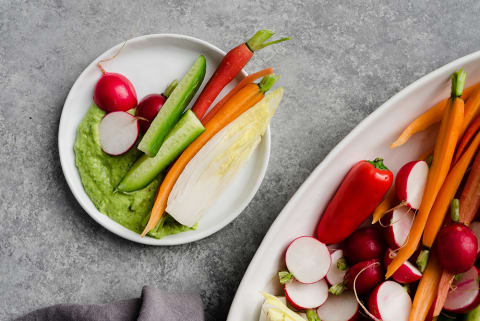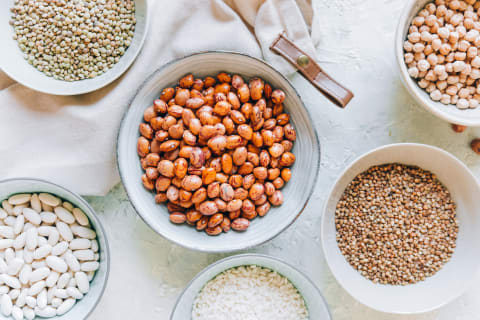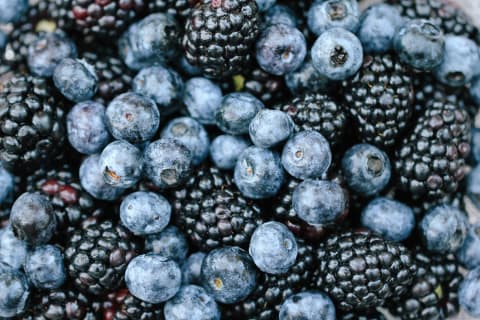Of course, truly sustainable diets need to take human livelihoods into account too. “Sustainability encompasses not only the environmental but also the social and economic equity aspects of the food system,” Kristin Reynolds, Ph.D., chair of food studies at The New School and lecturer at Yale School of the Environment, explains. In a study published earlier this year1, Rose and a team of researchers measured the carbon and water footprint of 16,800 Americans’ daily diets. They found that if the group with the most environmentally taxing diets made just one sustainable food swap a day, it would reduce their diet’s overall daily footprint by up to 48.4%. As Bergen notes, and this research demonstrates, “Even small diet changes can make a big difference.” Then, you have the emissions of the livestock itself. Ruminant animals (cows, sheep, and goats) are the worst offenders here. They have multiple stomach compartments that break down food through a fermentation process that releases methane—a powerful greenhouse gas that has 25 to 80 times the warming potential of carbon dioxide. “That methane gas is what’s really contributing to their impact,” Rose notes. According to one 2017 analysis, the overall environmental impact of ruminant meat is about 100 times that of plant-based foods. Not to mention, plant-forward diets tend to be healthier than carnivorous ones by most metrics. Livestock with a so-called monogastric (aka, one-chamber) stomach design (think chickens and pigs) do not emit methane and therefore tend to be a better pick from a sustainability perspective. But of course, the way an animal is raised also affects its overall impact. Grass-fed meat from a small farm that uses regenerative grazing practices will be a better choice for the environment, animal welfare, and human health than meat raised on a feedlot somewhere. Like every other sustainability conversation, this one is nuanced, and it doesn’t have easy answers. With that being said, the following foods tend to have the lowest environmental footprint in terms of water use, land use, and greenhouse gas emissions. If you’re looking to eat more sustainably (and oftentimes, more healthily), this list is a good place to start: As far as specific produce items that require the fewest resources to grow, onion, celery, potatoes, and carrots topped one 2015 study on the foods with the lowest global warming potential by weight. Foods grown outdoors tend to be less resource-intensive than those grown in climate-controlled greenhouses. However, the seafood industry is rife with human rights abuses (read a marine scientist’s take on the issue here), so it’s important to know where your seafood is coming from, no matter what you’re buying. Swap for: Plant-based protein, chicken, or pork Swap for: Plant-based protein, chicken, or pork Swap for: Plant-based protein, chicken, or pork Swap for: Nondairy milk Swap for: Cashew “cheese,” tahini, plant-based yogurts Swap for: The smaller fish listed above (salmon, mackerel, anchovies, sardines, herring) Swap for: Filtered water from the tap Swap for: Seasonal fruits or preserved jams Swap for: RSPO-certified palm oil Swap for: Honey or maple syrup “We all throw out too much food,” Rose says, but you can keep waste to a minimum by planning your meals ahead of time, only buying what you need, and getting creative with your scraps using recipes like these: And here’s yet another reason to avoid cooking with meat: Animal scraps don’t belong in your bin! “A caution, however, is that making these types of changes is not a stand-in for systems-level and policy changes that can support more sustainable and equitable food systems,” Reynolds adds, bringing us to the final point. “Readers can take steps to learn about similar policies, or efforts to create them, where they live and support policymakers who are making well-informed and community-driven food policy a priority,” Reynolds adds. Emma received her B.A. in Environmental Science & Policy with a specialty in environmental communications from Duke University. In addition to penning over 1,000 mbg articles on topics from the water crisis in California to the rise of urban beekeeping, her work has appeared on Grist, Bloomberg News, Bustle, and Forbes. She’s spoken about the intersection of self-care and sustainability on podcasts and live events alongside environmental thought leaders like Marci Zaroff, Gay Browne, and Summer Rayne Oakes.








